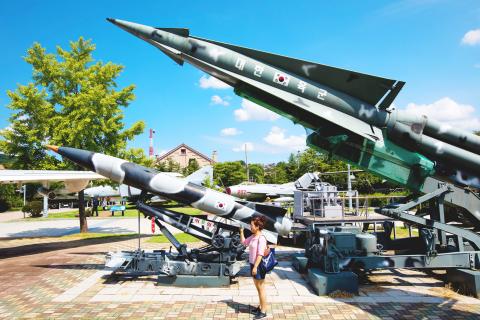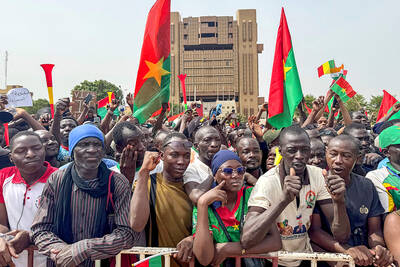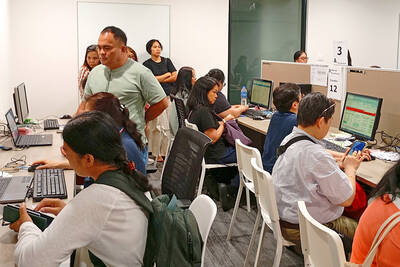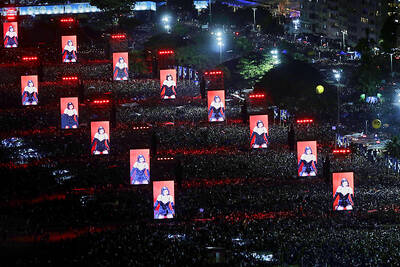Amid North Korea’s missile stand-off with the US, calls are mounting in South Korea for Seoul to build nuclear weapons of its own to defend itself.
The South, which hosts 28,500 US troops on its soil to defend it from the North, is banned from building its own nuclear weapons under an atomic energy deal it signed in 1974 with Washington, its security guarantor that instead offers Seoul a “nuclear umbrella” against potential attacks.
However, with Pyongyang regularly threatening to turn Seoul into a “sea of flames” — and nagging questions over Washington’s willingness to defend it if doing so put its own cities in danger of retaliatory attacks — the South’s media are leading calls for a change of tack.

Photo: Bloomberg
South Korea, which fought a war with the North that ended in a stalemate in 1953, is highly technologically advanced and analysts estimate it could develop an atomic device within months of deciding to do so.
“Now is time to start reviewing nuclear armament,” the Korea Herald said in an editorial yesterday.
After Pyongyang conducted two successful tests of intercontinental ballistic missiles last month, putting much of the mainland US within reach, the newspaper said: “Trust in the nuclear umbrella the US provides to the South can be shaken.”
It urged Washington to deploy some of its atomic weapons to South Korea if it did not want to see a nuclear-armed Seoul.
The US stationed some of its atomic weapons in the South following the 1950 to 1953 Korean War, but withdrew them in 1991 when the two Koreas jointly declared they would make the Korean Peninsula nuclear-free.
However, Pyongyang carried out its first nuclear test in 2006 and formally abandoned the deal in 2009.
Tensions have soared in recent months with US President Donald Trump this week warning of “fire and fury” against Pyongyang, which threatened missile strikes near the US territory of Guam.
The North’s military chief Ri Myong-su responded saying that if the US continued in its “reckless” behavior, Pyongyang would “inflict the most miserable and merciless punishment upon all the provokers.”
The latest war of words between Trump and the North — ruled by Kim Jong-un — unnerved many in the South, even though it has become largely used to hostile rhetoric from its neighbor.
A conflict between the North and the US could have devastating consequences for Asia’s fourth-largest economy, with Seoul within range of Pyongyang’s vast conventional artillery forces.
“A catastrophe is looming,” the South’s top-selling Chosun daily said in an editorial this week. “All options, even those considered unthinkable so far, must be on the table.”
In all the North has staged five atomic tests — including three since Kim took office — as it seeks to develop a nuclear-tipped missile capable of hitting the continental US.
A survey last year — even before tensions began to mount — showed that about 57 percent of South Koreans already supported the idea of nuclear armament, with 31 percent opposing it.
“We need to have our own military options to overwhelm the North,” the Korea Economic Daily said in an editorial this week, calling for nuclear weapons to ensure a “balance of terror” and prevent Pyongyang from attacking the South.
However, a South Korean bomb would infuriate Pyongyang, which says it needs nuclear weapons to defend itself against the threat of invasion, and make bringing it to the negotiating table even harder.
South Korean Minister of National Defense Song Young-moo said recently that the South was “fully capable” of building its own nuclear weapon, but was not considering the option for now.
Atomic arms are not the only way Seoul can step up its defenses.
Song is pushing for the development of nuclear-powered submarines, although doing so also requires consent from the US.
South Korean President Moon Jae-in has also urged limits on Seoul’s missiles to be increased in a conversation with Trump.
At present, Seoul is allowed to possess ballistic missiles with a range of 800km and payload of 500kg. It wants the weight limit raised to 1,000kg.
The Pentagon on Monday said it was “actively” considering the revision.

Kehinde Sanni spends his days smoothing out dents and repainting scratched bumpers in a modest autobody shop in Lagos. He has never left Nigeria, yet he speaks glowingly of Burkina Faso military leader Ibrahim Traore. “Nigeria needs someone like Ibrahim Traore of Burkina Faso. He is doing well for his country,” Sanni said. His admiration is shaped by a steady stream of viral videos, memes and social media posts — many misleading or outright false — portraying Traore as a fearless reformer who defied Western powers and reclaimed his country’s dignity. The Burkinabe strongman swept into power following a coup in September 2022

A new online voting system aimed at boosting turnout among the Philippines’ millions of overseas workers ahead of Monday’s mid-term elections has been marked by confusion and fears of disenfranchisement. Thousands of overseas Filipino workers have already cast their ballots in the race dominated by a bitter feud between President Ferdinand Marcos Jr and his impeached vice president, Sara Duterte. While official turnout figures are not yet publicly available, data from the Philippine Commission on Elections (COMELEC) showed that at least 134,000 of the 1.22 million registered overseas voters have signed up for the new online system, which opened on April 13. However,

‘FRAGMENTING’: British politics have for a long time been dominated by the Labor Party and the Tories, but polls suggest that Reform now poses a significant challenge Hard-right upstarts Reform UK snatched a parliamentary seat from British Prime Minister Keir Starmer’s Labor Party yesterday in local elections that dealt a blow to the UK’s two establishment parties. Reform, led by anti-immigrant firebrand Nigel Farage, won the by-election in Runcorn and Helsby in northwest England by just six votes, as it picked up gains in other localities, including one mayoralty. The group’s strong showing continues momentum it built up at last year’s general election and appears to confirm a trend that the UK is entering an era of multi-party politics. “For the movement, for the party it’s a very, very big

ENTERTAINMENT: Rio officials have a history of organizing massive concerts on Copacabana Beach, with Madonna’s show drawing about 1.6 million fans last year Lady Gaga on Saturday night gave a free concert in front of 2 million fans who poured onto Copacabana Beach in Rio de Janeiro for the biggest show of her career. “Tonight, we’re making history... Thank you for making history with me,” Lady Gaga told a screaming crowd. The Mother Monster, as she is known, started the show at about 10:10pm local time with her 2011 song Bloody Mary. Cries of joy rose from the tightly packed fans who sang and danced shoulder-to-shoulder on the vast stretch of sand. Concert organizers said 2.1 million people attended the show. Lady Gaga